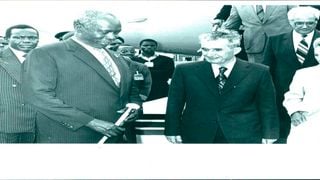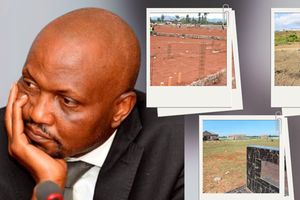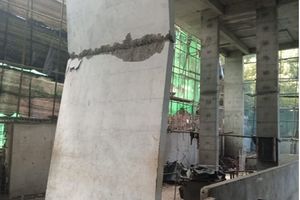
President Daniel Arap Moi welcomes his Romanian counterpart Nicolae Ceausescu (centre) upon arrival at the Jomo Kenyatta International Airport in 1988. On the right is Madame Elena Ceausescu.
| File | Nation Media GroupNews
Premium
The notorious Romanian dictator who taught Moi regime the art of brutality
What you need to know:
- It was during the height of the crackdown on Mwakenya members that Moi visited Romania on September 8, 1987.
- Those who have been through Nyayo House cringe at the mention of the Romanian dictator and his dalliance with Moi.
On the morning of September 6, 1988, a red carpet was rolled at the Jomo Kenyatta International Airport to receive a State guest: Romanian leader Nicolae Ceausescu – one of the most notorious dictators that ever lived.
Moi, perhaps, was sending a subtle message to one of his ardent critics – Raila Odinga - whom he had released and, in a span of six months, returned to detention. Whether this was a coincidence is not clear.
On February 5, 1988, exactly seven months before Ceausescu arrived – the then powerful permanent secretary for internal security Hezekiah Oyugi had herded some nine of the Nyayo detainees to a State House boardroom to meet with President Moi. The nine were Mr Odinga, Prof Katama Mkangi, Prof Ngotho Kariuki, Mr Patrick Onyango, Mr Israel Agina, journalist Paul Amina, Mr Jackson Ngola, Mr Herbert Lusiola and Mr Nicodemus Obiero.
Inside State House, they had been lectured by both Oyugi and then police Commissioner Phillip Kilonzo on how to behave: “(Oyugi) said that when Moi came in, we should all stand up and show respect,” recalled Raila in his book, The Flame of Freedom. The detainees had asked Raila to speak on their behalf and he had told Moi that detention without trial was unethical.
“I told him that the idea of detention without trial is reprehensible and inhuman. If a Kenyan has to be banished to prison for whatever reason, he should first go through the due process of law, rather than being incarcerated without the opportunity of a fair trial,” recalled Raila.
Before Ceausescu’s arrival, Moi was to use the release of the detainees as part of the launch of the 1988 queue-voting campaign propaganda. Insiders in the Nyayo regime say that Ceasescu’s notorious Securitate – the worst in eastern Europe – had trained some of the torturers based in Nairobi’s Nyayo House, who had turned the basement of the building into a waterlogged torture chamber.
So entrenched in the Romania was Securitate that by the time Ceausescu was killed by his own people, there were 500,000 informers within a population of 22 million which meant that every informer was assigned 44 people or as a Bucharest journalist once noted, the Securitate turned Romania into a “a big open prison.”
It was during the height of the crackdown on Mwakenya members that Moi visited Romania on September 8, 1987.
Horrifying stories about the torture that suspected Mwakenya members went through were starting to get space in the newspapers.
Nature of torture
The story of businessman Peter Njenga Karanja had stood out. He had been picked in February 1987 from his Chelsea Coffee House in Nakuru and taken to Nyayo House where he endured two weeks of torture before he died of internal bleeding.
It was during a public inquest that the nature of torture subjected to alleged members of Mwakenya became clear. “He appeared malnourished, restless and uneasy. He was weary looking, extremely sick, full of anxiety and not a forthcoming person,” Dr Peter Anthony Carberry, who had been hired by the family lawyer Dr Oki Ooko Ombaka told the court.
When he saw him, before he died, Karanja “was crumpled in a wheelchair. The ulcers on his body were bad, open and quite visible to the naked eye. The skin was badly shattered. The whole thing looked like a crater, a deep tissue with pus emanating from it.”
Even the government pathologist, Dr Jason Kaviti, had to admit that indeed Karanja had faced some torture and that his small and large intestines had ruptured.
“Karanja died like a caged animal as police stood guard over him throughout his dying moments,” ruled chief magistrate Joseph Mango, but could not attribute the torture to any police since the chief Mwakenya interrogator James Opiyo had “refused” to give the identity of the officers involved.
It was amidst such tortures that Moi flew to Romania for a meeting with Ceausescu. Those who have been through Nyayo House cringe at the mention of the Romanian dictator and his dalliance with Moi.
Goran Hyden, one of the most distinguished scholars on African politics and based at the University of Florida, keenly observed Moi’s dalliance with Ceausescu with a lot of interest.
While contributing a chapter in the Joel D. Barkan’s book, Beyond Capitalism, Prof Hyden rightly observed: “Moi was an admirer of Ceausescu’s Romania…Moi clearly felt more comfortable with the authoritarian model of the East than with the pluralist one of the West in building what might be best described as a clientelist machine to perpetuate his personal rule.”
Fall of Ceausescu regime
On January 14, 1988, the Romanian president dispatched his brother, Dr Ion Ceausescu, to State House Nairobi for talks with President Moi. This private meeting with Moi was styled as a “trade delegation” and was reported as such by the Kenya News Agency dispatch.
This follow up meeting was crucial for Moi and the kind of regime he had set up in Kenya. While there are few comparative studies on the Kenyan torture chambers and those of the Securitate in Bucharest, there are some observable similarities on the character of Moi and his comrade.
Moi and Ceausescu shared similar traits: “To his subjects, Ceausescu is all-knowing and omnipresent. The first half of the state television's single, two-hour weeknight program is customarily devoted to his activities and accomplishments, as are the front pages of the tightly controlled newspapers,” observed journalist David Binder in a 1986 article.
The same could be said of Moi. By the time Ceausescu flew to Kenya, the Presidential Press Unit had done documentary film praising the Romanian dictator while the newspapers carried several pages profiling the ‘Statesman”.
In Ceausescu’s eight-man delegation was his wife, Elena, and a notorious Minister for Foreign Affairs, Ioan Totu, who would later commit suicide in prison after the Ceausescu regime fell.
Elena was an interesting woman. Thought to be semi-illiterate by her enemies, it later emerged that she had a doctorate in chemical engineering written for her. Scientists were also forced to put her name as co-author of their papers and authored several books and academic papers on the “chemistry of rubber” in her name. A law that required PhD candidates to defend their work in public was swiftly changed and –somehow – she forced her name to be included in the prestigious Academy of Chemistry in London.
But Elena had dropped out of school aged 14 after failing all subjects but needlework and singing.
The arrival of the Ceausescus happened at a crucial time for Kenya. Six months back, on March 21, Kenya had conducted its sham queue voting General Election and Moi had just dropped his vice-President Mwai Kibaki as he embarked on the final process to isolate the independent-minded technocrats he had inherited from Jomo Kenyatta in 1978.
To mark his presence, Ceausescu was taken to Nairobi’s Uhuru Gardens in Langata where he planted a Mugumo tree.
Dreaded torture chambers
When Nyayo House was built, the torture chambers were not part of the basement which was a parking. But on the western side of the parking, some designed cells were reconfigured and equipped with equipment which could pump both hot and cold air depending on what the torturers wanted.
In his book, I Refuse to Die, Nyayo House veteran Koigi wa Wamwere described the place: “The cell was completely dark. When the door opened, a little light came in and revealed four walls painted black. Only one white button stood on the wall near the door. The cell had a thick layer of dust that smelt foul. I felt hard crusts on the floor that turned out to be dry human excreta. In one corner near the ceiling there was a glass-covered light that was never lit. Nearby, a powerful fan blew both cold and hot air alternatively. When it was blowing cold, the cell was like a deep freezer. When it blew hot air, it was like an oven…”
It was claimed that some of the torturers were trained by Ceausescu’s Securitate – and that those who had not returned by the time the dictator fell were caught up in the chaos that ensued.
When the Romanians finally got tired of the dictator, they chased him out of town and caught up with him as he fled. He was put on a trial that lasted two hours. It was Christsmas and the two were taken to a freezing courtyard and shot.
It was Presbyterian Church leader Rev Timothy Njoya who called for an end to single-party rule arguing that the events in Eastern Europe a few days earlier could have ramifications on Kenya. Rev Njoya must have been alluding to the uprising in Romania but Kanu secretary-general, Peter Oloo Aringo, called him a mad man.
“Let me remind him that the honourable Jean Marie Seroney and Martin Shikuku were both picked out of inside Parliament in the 70s and taken to detention when the government felt that would be the best way to safeguard the country’s security and interests,” warned Elijah Mwangale – the man who had been used by Moi to tame Kibaki’s rise.
Attempts to remove Moi’s brutal regime led to the creation of vicious lobby groups whose code-name was terror. They wanted the status quo. The rest is history.
Meanwhile, the Ceausescu’s Securitate archives have survived and they have started to interest scholars. But looking back, the Romanian dictator taught us bad manners.
[email protected] @johnkamau1





